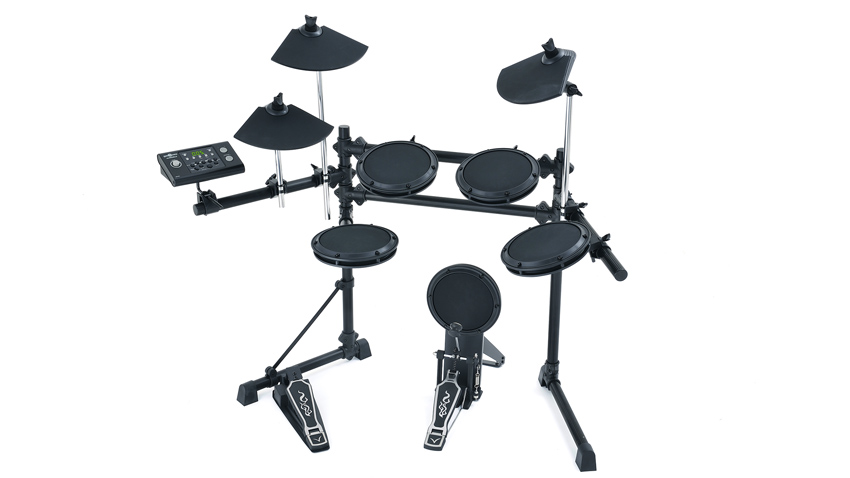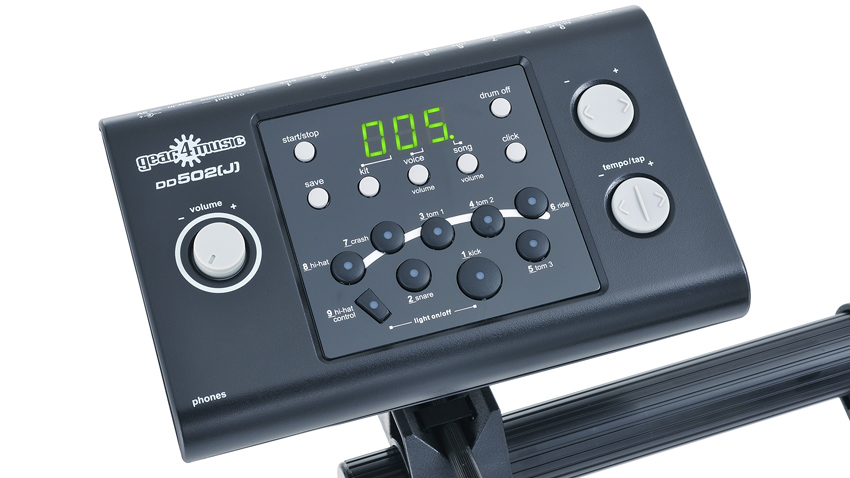MusicRadar Verdict
Even though technology has moved on significantly since the DD502(J) was first introduced, this electronic kit still represents good value for money.
Pros
- +
The pads are reasonably responsive. You can fit your own heads.
Cons
- -
Machine gun snare effect is noticeable. Can't adjust parameters on a per-pad basis.
MusicRadar's got your back

Gear4Music DD502(J)

Gear4Music DD502(J)
The DD502(J) is just one of over 14,000 music-related products currently offered by web-based Gear4Music, which sources its products from a variety of manufacturers from around the globe. This electronic drum set is manufactured by Medeli, a huge Chinese corporation which specialises in the development, design and manufacture of electronic musical instruments.
Like its smaller-footprint DD501 cousin, this kit has been in circulation for over three years full service, yet it manages to retain some credible features for those on a tight budget.
Build
As with any standard electronic kit, this set revolves around an 'H' framed rack to which all the pads attach. The drum module (or brain) is the centre-piece. This rack is pretty substantial with its length-on serrations embedded into the extrusions of the standard 1½" diameter tube. This creates a rack which is both strong and rigid while also providing each of the plastic pads and rack clamps with an excellent surface to grip.
The black finish plastic-encased module features an intuitive layout and has a raft of controls, including push buttons and a single large rotary volume. It would have been nice to have a larger start\stop button so that it could be accessed with a stick, for example, but each of the buttons appears conveniently positioned and well-placed for user performance. The single zoned drum pads are made from plastic, with rubberised heads stretched over a soft sponge-type material. The cymbal pads (also single zone), are the familiar budget-style triangular shaped plastic affairs finished in black.
Occupying the lower section of the module is a graphic representation of the whole kit. When any of the voices are sounded or triggered (either when striking one of the pads or playing one of the 50 preset songs), at the same time as the voices are heard the individual pads illuminate. To the rear of the module is a large single winged nut with an integral clamp to attach the module onto the drum rack.
This module offers a tap tempo facility, activated during the playback of any of the onboard preset songs. We are not sure exactly why, but although the requirement is four taps on the button it's just the last two which actually alter the tempo. The DD502 hasn't quite got the sophistication of some of the more expensive setups which offer adjustable parameters for individual pads, but you do have the facility to alter the volume of each pad in a user kit.
To the rear of the module there is a row of ¼" jack sockets numbered from 1 to 9 for each of the drum and cymbal pads, the stereo outputs (L/Mono and R) and an aux. in. There is a further ¼" socket that's conveniently placed at the right-hand side of the module for the headphones. Lastly, we have a MIDI Out which allows connection to any MIDI compatible module or computer with a MIDI socket - this socket is perhaps the biggest clue to the age of the unit, as most modern modules feature USB connectivity.
Want all the hottest music and gear news, reviews, deals, features and more, direct to your inbox? Sign up here.
Hands On
One of the unique features of this kit (mentioned on the G4M website) is the facility for the user to fit their own heads. However, we think the pads feel good and would be inclined to change them only if they began to show significant signs of wear. We must admit that even after some lengthy playing during the review, they showed hardly any signs that the stick-resilient rubber had even been struck.
As the sticks bounce around on each of these pads, (even with the occasional miss hit), the trigging is fairly impressive. There is, however, no in-built provision to counteract the dreaded machine gun effect from the snare.
Checking out each of the preset songs demonstrates some of potential and the pitfalls of the module. Some songs are so cheesy (and then some!), while others are actually quite enjoyable and will prove useful for a beginner. At least there is the option to mute the drums while you copy what the programmer has interpreted as 'drumming', though some of the rhythm tracks lack the feel and expression that you'd associate with a real player. However, rectifying this problem could be the first job for the user!
The manual suggests that the "lighting guide function" (where the corresponding LED illuminates as each pad sounded) could be a good method of learning to play the kit but, in practice, we found that, unless the tempo is slowed right down and the beat is basic, you'll have a really hard job keeping up!